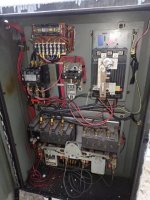Sweet Dreamer
Aluminum
- Joined
- May 26, 2013
- Location
- Pennsylvania
Here's a photo of the electrical cabinet on my No. 3

The gray box in the upper right corner is the main OFF/ON switch.
There are two very large relays at the bottom of the cabinet.
There is another smaller relay midway up on the left side.
And finally there is what appears to be a 2-poll relay in the middle of the cabinet.
I haven't gone through this yet to determine exactly what each relay does. At first I thought there might be relays for forward and reverse (as per the schematic), but DocsMachine reminded me that the forward and reverse are done mechanically in the headstock with gears and clutches. There's also no electrical switches for forward and reverse. The only electrical switches on the lathe are 3 push buttons. OFF, LOW, and HIGH.
There are definitely two motors on this lathe. The main motor in the base, and another motor mounted on the side of the electrical cabinet to run hydraulic for the collet closer.
You can see the hydraulic pump motor in this photo:


The gray box in the upper right corner is the main OFF/ON switch.
There are two very large relays at the bottom of the cabinet.
There is another smaller relay midway up on the left side.
And finally there is what appears to be a 2-poll relay in the middle of the cabinet.
I haven't gone through this yet to determine exactly what each relay does. At first I thought there might be relays for forward and reverse (as per the schematic), but DocsMachine reminded me that the forward and reverse are done mechanically in the headstock with gears and clutches. There's also no electrical switches for forward and reverse. The only electrical switches on the lathe are 3 push buttons. OFF, LOW, and HIGH.
There are definitely two motors on this lathe. The main motor in the base, and another motor mounted on the side of the electrical cabinet to run hydraulic for the collet closer.
You can see the hydraulic pump motor in this photo:








